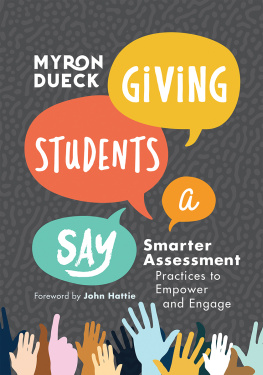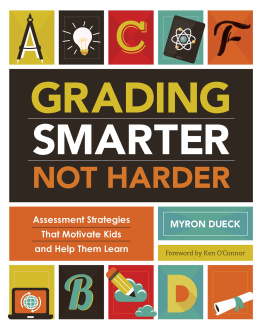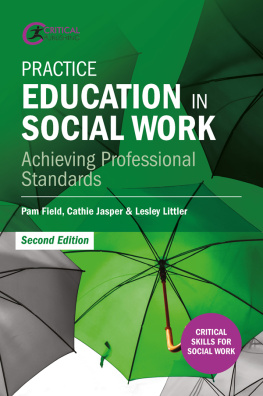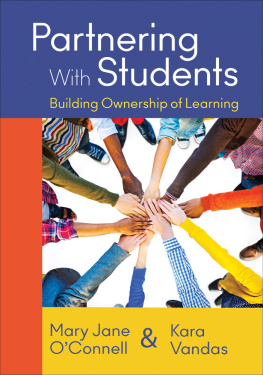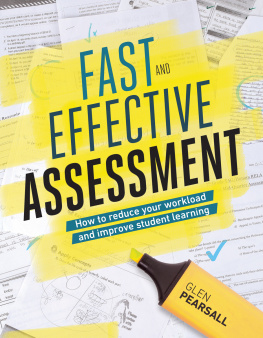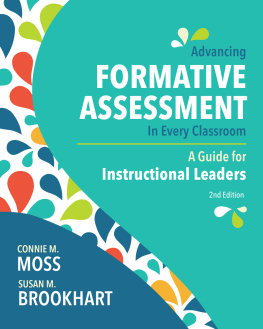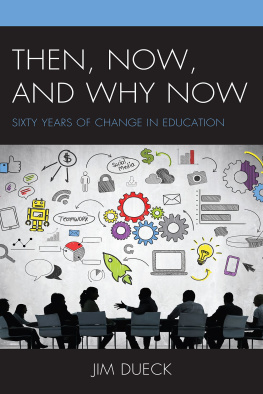Contents
Guide
Pages
ASCD Member Book / Also by the Author
....................
Many ASCD members received this book
as a member benefit upon its initial release.
Learn more at www.ascd.org/memberbooks
Also by the author
Grading Smarter, Not Harder: Assessment Strategies That Motivate Kids and Help Them Learn
Dedication
....................
To all the students I've learned from:
Your voices, opinions, and honesty
made me a better educator.
Foreword
....................
Come into the elevator.
Some years ago, I led a team to develop the assessment scheme for New Zealand elementary and high schools (https://e-asttle.tki.org.nz), and New York City was interested in adopting it. My bosses told me that in business and politics, it is critical to get the elevator pitch perfect, since you often have only one chance to get the message across. My business developer worked on the pitch and trained me with religious zeal in delivering it before we went off to New York. Once there, we just happened to enter an elevator at the same time as Joel Klein, then-chancellor of the New York City Department of Education. Somehow my perfectly prepared elevator pitch went by the wayside, and we talked about sheep.
I now have the chance to deliver another elevator pitch, so here goes: "Assessment is something we have done to students rather than with them." Pause and reread this message. If one sentence sums up the reason this book was written, this is it. This book's aim is for educators to work with students for a most just cause: to help students become confident learners who can interpret assessment information, use it to improve their learning outcomes, and be better prepared for the various challenges they encounter. The importance of this pitch is why I was honored to be asked to write this foreword.
I have worked in assessment for most of my career, and within the assessment community, we moved from seeing tests as valid if they measure what they intended to seeing tests as valid if the interpretations are defensible. In other words, if a test doesn't result in any consequential reflection, interpretation, decision making, or action, then it doesn't matter if it has all the lovely measurement properties that we psychometricians love. This shift, beginning in the 1990s, has allowed the measurement community to come into closer contact with classroom teachers to help them reliably interpret assessment data, make decisions based on the data, and act on those decisions. These skills are precisely the ones we also need to teach students. We should see the score as but the starting point.
But for too many students, the score is the end point, and the number screams to them that the work is now over. They know how to interpret the score relative to the scores of their peers, and they know that 100 percent is perfect (although in reality, 100 percent usually means that the work was too easy). Such a narrow interpretation of the score won't tell them about their gaps, strengths, and misunderstandings or help them decide what to do next.
I'd like to invite you to carry out two simple tasks. First, ask your students to grade their own performance on the next test before they start it. Second, after you have graded the test and written thorough comments, ask your students to write a short list of statements describing what they have learned about their learning and where they need to move next in light of your grade and comments. The results of this experiment will likely bear out what research suggests: that from about age 8 onward, students are quite accurate in determining their place in the achievement equation and predicting their scoresand that teacher grades and comments do little to help students understand what they've learned and where they need to go next.
After students complete a test, we should be asking ourselves what we learnedabout what we taught well, whom we taught well, and the magnitude of growth that students have made from the beginning of the learning period to this point. Asking these questions will result in more informative tests both for teachers and for students.
Throughout this book, the notion of assessing with students is termed as a student-centered approach to assessment. With this approach, assessments do not dominate students' radar (as revealed by the eternal question "Will this be on the test?") but, rather, are seen as a supportive interpretive method to enhance student learning. This approach ensures that learning targets, instruction, learning tasks, success criteria, and rubrics are aligned with assessment. What is valued should be ever-present and aligned; therefore, the test does not dominate but becomes part of the learning process.
Assessment applies to so much more than achievement; it can be an invaluable tool to help us understand and effectively use learning strategies. Myron explores such notions as retrieval versus storage strength, desirable difficulties, solution generation effects, how to persist and enjoy challenges, spaced versus massed practice, and interleaving rather than blockingideas that have been known for decades in learning theory but rarely are practiced by those most empowered to influence learning. One fascinating idea is that rubrics can be powerful learning aids. I disagree with the common belief that rubrics' main purpose is to assess performance: of course they do that, but they also help students dive deeper and spread their wings of knowing, and they guide students' progression to a lesson's success criteria. Myron's exploration of rubrics as learning tools is just one of the powerful applications of ideas that make this book so practical for teachers and bring to life the goal of assessing with students.
Myron ends the book back in the elevator. If it were me in this elevator, I would ponder all my missed opportunities to talk about something other than sheep: If only I had thought of presenting these great assessment ideas, if only I had the richness of experience and practice that is evident throughout this book, if only I had focused on conducting assessment with students rather than administering it to students. Never mind. Myron is here, and he has done it for us.
John Hattie
Acknowledgments
....................
Students
I'll speak generally for teachers by saying that we like schools: the classrooms, labs, hallways, theaters, and gymnasiums conjure good memories. Many of us gravitated back to school for our careers based on these positive experiences. I have come to realize, however, that many students' feelings about school range from passive disinterest to abject fear. For these kids, coming to school is a struggle. So I first want to acknowledge all students: without you, this book simply wouldn't exist. Thank you for your honesty, courage, and feedback. Thank you for teaching me to listen.
I also want to acknowledge a few specific students. Malaina, thank you for providing the quote that in many ways encapsulates the theme of this book: "No one knows me like I know me." Xavier, thank you for digging into your school experience and providing a candid appraisal. Rayman, thank you for raising a valid concern about assessment and being willing to engage in conversation about it. I wish many more students would do the same.

